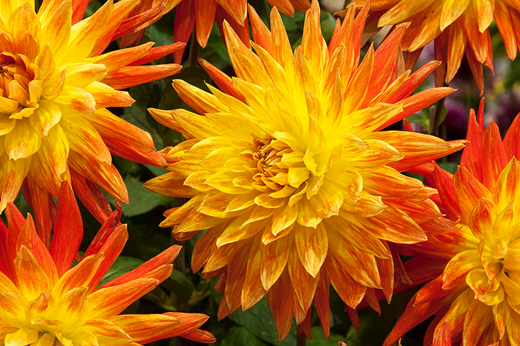 Sowing and planting
Sowing and planting
Towards the end of August sow hardy annuals directly into borders. They will overwinter and flower next summer.
Cutting back, pruning and dividing
Cutting back the foliage and stems of herbaceous plants that have already died back (e.g. Dicentra) is starting to be a priority.
Don't neglect hanging baskets - deadheading, watering and feeding will help them last through until autumn.
Deadhead plants such as Dahlia, roses and Penstemon and bedding to prolong the display colour well into early autumn.
Don't cut off the flowerheads of ornamental grasses. These will provide winter interest.
Hardy geraniums can be cut back a little to remove tired leaves and encourage a new flush of growth.
Prune climbing and rambling roses that do not repeat flower or produce attractive hips, once the flowers have finished.
Propagation
Pinks and carnations can be propagated by layering. Propagate irises by dividing the rhizomes if not done last month.
Take cuttings of tender perennials such as Pelargonium and Osteospermum, as soon as possible. A greenhouse, cool conservatory or a light windowsill are ideal to bring them on until they are established.
Rock garden plants, such as Helianthemum, Aubrieta and Dianthus can be propagated from cuttings at this time of year.
General maintenance
Feed containers, and even tired border perennials, with a liquid tomato food each week to encourage them to bloom into the early autumn.
Keep picking flowers from the cutting garden to encourage more flower buds to form and open.
Alpines that have developed bare patches of die-back, or have become weedy, can be tidied up by in-filling the patches with gritty compost. This will encourage new growth as well as improving their appearance.
Most perennial weeds are best dealt with when in active growth.
Planning ahead
Collect and store seed of hardy annuals and perennials for sowing later in the autumn. Good plants to try include Calendula , Nigella , Cerinthe , Papaver , Aquilegia and hardy Geranium.
Buy or order spring-flowering bulbs. Some bulbs can be planted now, such as Colchicum, daffodils and Madonna lilies (L. candidum).
Pest and disease watch
Inspect chrysanthemums for the first signs of white rust and take immediate action.
Remove and destroy any Nicotiana showing signs of downy mildew. This shows up as yellowish blotches on the upper surface of the leaves.
A white silvery coating on the leaves of some perennials and shrubs caused by the fungus powdery mildew can be seen at this time of the year, although unsightly it’s not usually harmful to plants.
Apply nematodes to control vine weevil grubs, in pots or the ground.
If your dahlia blooms are ragged, earwigs are the likely cause of the damage, so fill small pots with shredded newspaper and place upturned on canes to trap them overnight.
Don't be worried by bright green, heavily-armoured looking insects on your plants - these are harmless shieldbugs which do not require control.
Distortion on Phlox could indicate the presence of phlox eelworm.
Discoloured leaves on herbaceous plants such as Chrysanthemum, Anemone and Penstemon may be leaf and bud eelworm.

